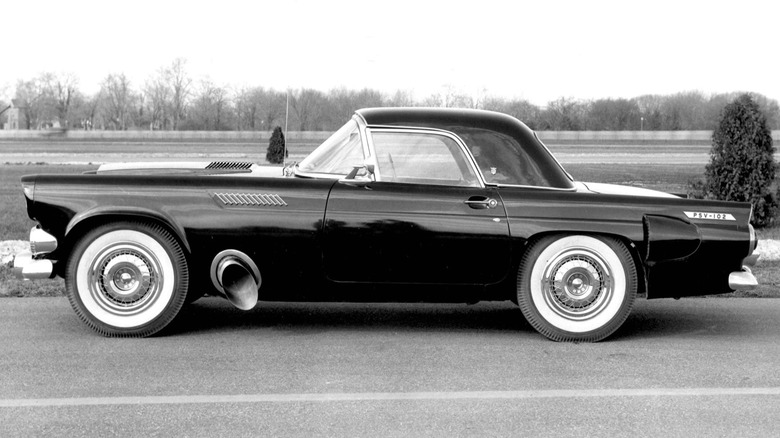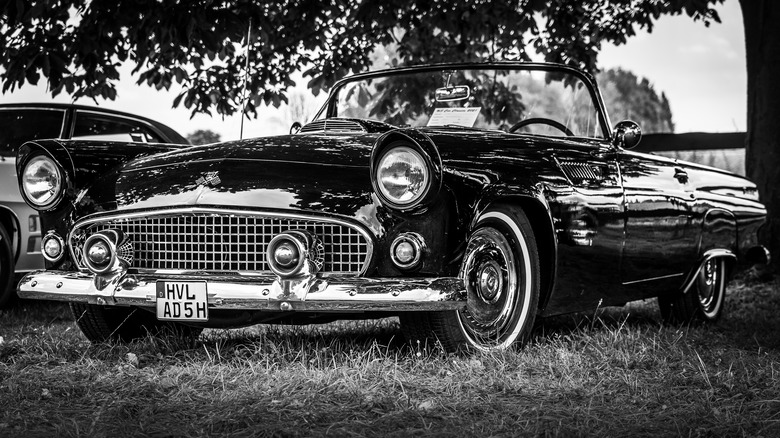The Fascinating True Story Behind Ford's Turbine-Powered Thunderbird
The 1950s marked the beginning of the space race, and the entire world was fascinated by rockets, jet engines, UFOs, and everything that had to do with the vast unknown. Before the Soviet Union launched Sputnik, the world's first artificial satellite to enter Earth's orbit (an event that formally kick-started the space race), automakers had figured out ways to make turbine engines fit the confines of a roadgoing car.
According to Goodwood, British automaker Rover was the first car company to create a gas turbine-powered vehicle, the P4-based JET1 speedster prototype, in the winter of 1949. The concept went on to race at the Le Mans 24 Hours between 1963 to 1965 as a non-competing invited entry. On the other side of the pond, Chrysler made headlines in 1962 with its majestic, Ghia-designed Turbine Car. Believe it or not, 50 units of the Turbine Ghia made it to American families for real-world testing. It is now the "most collectible American car," according to Jay Leno via Carnewscafe.
But before that, Ford came up with something unexpected for its then-newly-launched Thunderbird sports car. It never made it to production, but it showcased what "American muscle" really meant before the advent of Detroit muscle cars.
Ford Turbine Thunderbird: An experiment gone right
American auto pioneer Ford debuted the Thunderbird on February 20, 1954, at Detroit's first post-war auto show. But in December 1955, Ford engineers were experimenting with shoehorning a Boeing T50 turboshaft engine under the Thunderbird's hood. Ford archivist Ted Ryan shared a Twitter post of the Thunderbird Turbine concept last March 31, 2022, and he was kind enough to include the actual testing notes of the project.
According to the archives, Ford built the Turbine Thunderbird "to obtain a usable and reliable gas turbine vehicle for appraising" while studying the "special advantages and problems associated with this type of powerplant." The engine in question is a Boeing 502-8C Series that pumped out 175 horsepower and tipped the scales at about 330 pounds (150 kgs), said Macs Motor City Garage.
To help reduce costs, Ford routed gigantic exhaust pipes through the front fenders, creating an aggressive, muscle car vibe. It also came with a unique raised hood with scoops and louvers at the rear. Other neat design cues include relocated parking lights, bespoke side air intakes flanking the front grille, and aircraft-inspired air scoops behind the rear fenders.
The good and the bad
The idea of a turbine-powered Thunderbird looks good on paper, and it's safe to say that Ford also nailed the design aspect. But according to Ford's report, the concept's performance was a mixed bag. There was "serious acceleration lag in start-up" despite offering "good medium speed performance." The positive aspects include a brilliant power-to-weight ratio, no vibrations, and negligible routine maintenance since jet engines have fewer moving parts.
The downsides? Ford mentioned "the undesirability of the front exhaust," which we reckon pumped ear-busting decibels of noise inside the cabin, not to forget the heat emanating from an aggressive, powerful gas-fed jet engine used to power military tanks and antisubmarine drone helicopters. Furthermore, the project cost Ford $188,000, a considerable amount of money in 1955. The Thunderbird Turbine never made it to production (unlike the limited-series Chrysler Turbine Ghia), but the standard Thunderbird lasted ten generations before exiting the market in 1997. Ford revived the Thunderbird name in 2002 with the eleventh-generation variant, but it was canceled three years later in 2005 due to lagging sales numbers.

